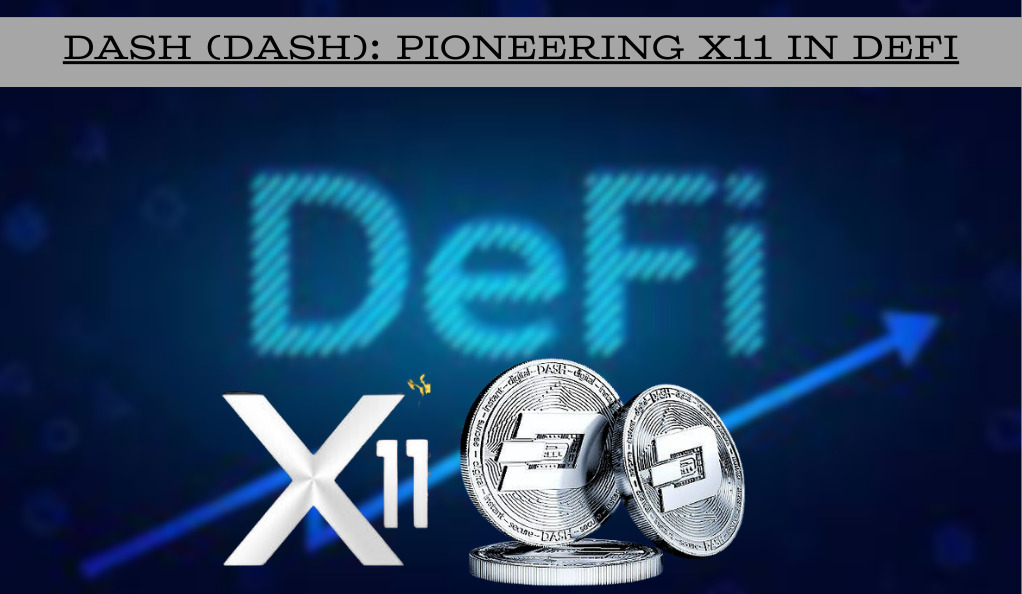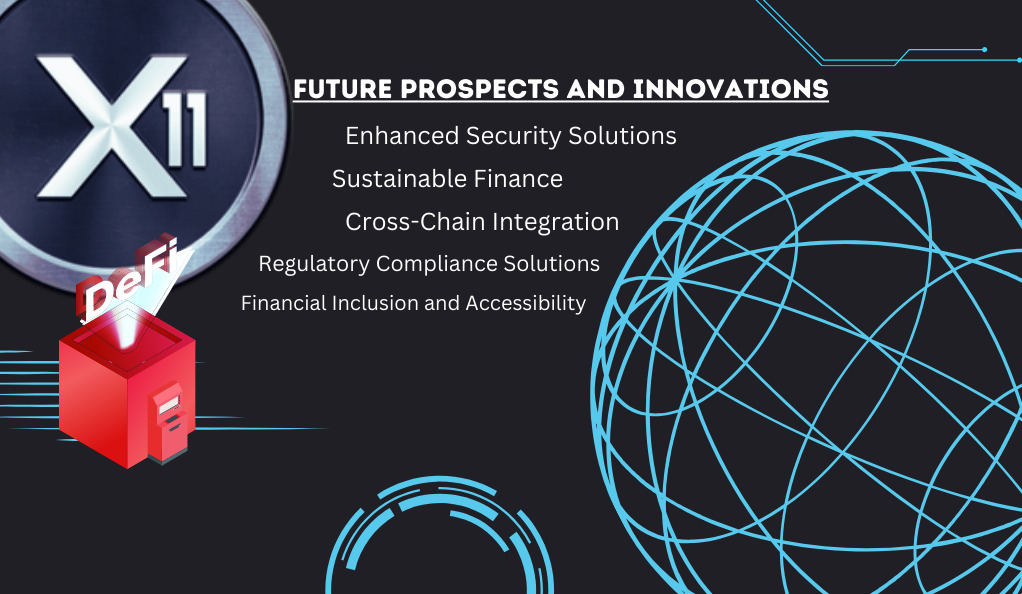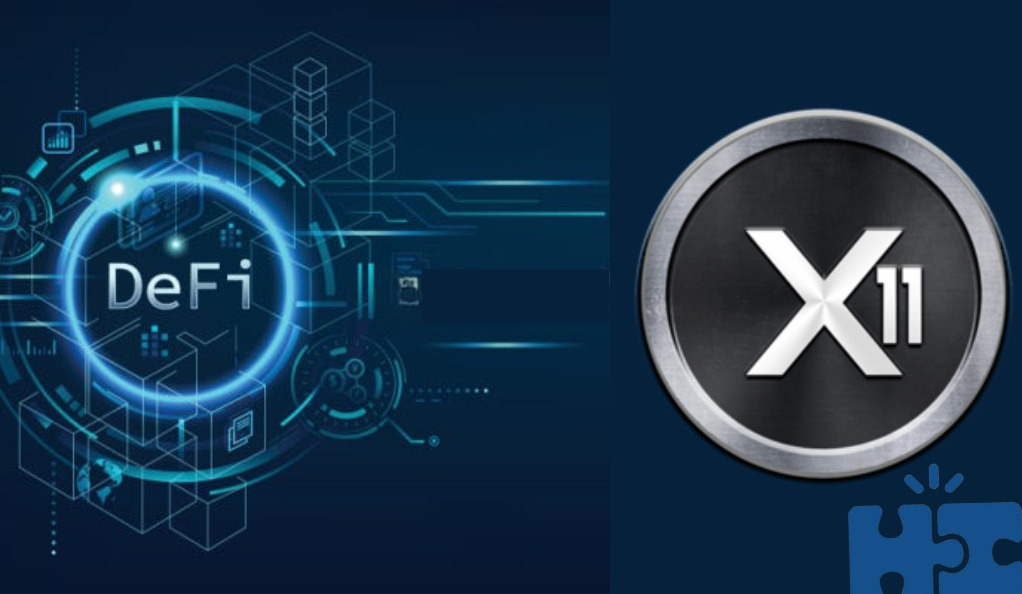In the ever-evolving landscape of blockchain and cryptocurrencies, one of the most groundbreaking developments of recent years has been the rise of Decentralized Finance, or DeFi. DeFi represents a fundamental shift in how financial systems operate, enabling users to access a wide range of financial services without the need for traditional intermediaries like banks. Concurrently, a unique algorithm, X11, has been quietly making its presence felt in the cryptocurrency world. In this article, we will delve into the fascinating intersection of DeFi and the X11 algorithm, exploring how these two distinct innovations have found a perfect match.
DeFi Revolution: A Game Changer
To understand the synergy between DeFi and X11, it’s crucial to first grasp the significance of the DeFi revolution.

Decentralized Finance (DeFi) Defined
Decentralized Finance, or DeFi for short, refers to a burgeoning ecosystem of blockchain-based applications and platforms that aim to recreate traditional financial services in a decentralized manner. Unlike traditional financial systems, where banks and financial institutions act as intermediaries, DeFi platforms utilize smart contracts and blockchain technology to enable peer-to-peer transactions and automated financial services.
The Core Principles of DeFi
At the heart of DeFi are several core principles that set it apart from traditional finance:
- Decentralization: DeFi operates on a decentralized network of computers, removing the need for centralized authorities.
- Transparency: All transactions on DeFi platforms are recorded on a public blockchain, ensuring transparency and immutability.
- Accessibility: DeFi platforms are open to anyone with an internet connection, promoting financial inclusion on a global scale.
- Interoperability: DeFi projects often collaborate and build on top of each other, creating a seamless ecosystem of interconnected services.
| Key Benefits of DeFi | Description |
|---|---|
| Financial Inclusion | DeFi can provide financial services to unbanked and underbanked populations worldwide. |
| Reduced Costs | DeFi platforms offer financial services at a fraction of the cost by eliminating intermediaries. |
| Global Reach | DeFi platforms are accessible globally to anyone with an internet connection, enabling global access. |
| Innovation | DeFi has driven innovation in lending, borrowing, trading, and yield farming, creating diverse financial products and services. |
Understanding the X11 Algorithm
Before we explore how the X11 algorithm complements the DeFi ecosystem, it’s essential to gain a comprehensive understanding of the X11 algorithm itself.
An Introduction to X11
The X11 algorithm is a cryptographic hashing algorithm designed to enhance the security and efficiency of blockchain networks. Created by Evan Duffield, the X11 algorithm made its debut in 2014 as part of the Dash cryptocurrency’s blockchain.
The Technical Underpinnings of X11
X11 is renowned for its technical sophistication, employing a sequence of 11 different hashing functions to secure and validate transactions on a blockchain. These functions include popular cryptographic algorithms such as Blake, Groestl, and Keccak, among others. This multi-layered approach enhances the algorithm’s resistance to attacks and its overall security.
Benefits of the X11 Algorithm
The X11 algorithm offers several advantages that have made it an appealing choice for various blockchain projects:
- Enhanced Security: The combination of multiple hashing functions makes X11 highly resistant to brute force and cryptographic attacks, ensuring the integrity of blockchain data.
- Energy Efficiency: Compared to some other proof-of-work (PoW) algorithms, X11 is more energy-efficient, which can be particularly appealing in an era of growing environmental concerns.
- ASIC Resistance: X11 was initially designed with the intention of being resistant to application-specific integrated circuits (ASICs), which can lead to a fairer distribution of mining rewards.
- Decentralization: By being ASIC-resistant, X11 promotes a more decentralized network, preventing a concentration of mining power in the hands of a few entities.
X11 Beyond Mining
While X11 was initially developed for cryptocurrency mining, its versatility extends far beyond that. Developers have recognized its potential in other applications, including its synergy with DeFi.
In the next section, we will explore the unique ways in which the X11 algorithm aligns with the core principles of DeFi, making it a perfect match for the decentralized finance ecosystem. We will delve into the practical applications and projects that have leveraged this combination to create innovative financial solutions.
The Synergy Between DeFi and X11
Now that we have a firm grasp of the DeFi ecosystem and the X11 algorithm, let’s delve into how these two innovative concepts synergize seamlessly, creating exciting opportunities for the future of finance.
DeFi Principles Aligned with X11
DeFi’s core principles of decentralization, transparency, accessibility, and interoperability align harmoniously with the characteristics of the X11 algorithm:
- Decentralization Harmony: DeFi platforms operate on decentralized networks, and X11 promotes decentralization by resisting centralization through ASIC resistance.
- Transparent Transactions: The transparent and immutable nature of blockchain transactions in DeFi is reinforced by X11’s robust security, ensuring the integrity of financial data.
- Accessibility and Inclusivity: X11’s energy efficiency and resistance to ASIC mining contribute to a more accessible and inclusive ecosystem, opening the doors to a broader range of participants.
- Interoperability Potential: DeFi’s penchant for collaboration and interoperability dovetails with X11’s adaptability, potentially leading to a more integrated and efficient financial ecosystem.
| Key Benefits for DeFi Platforms using X11 | Description |
|---|---|
| Enhanced Security | X11 employs a multi-layered approach that enhances the security of DeFi platforms, protecting them from malicious attacks and vulnerabilities. |
| Energy Efficiency | DeFi projects using X11 can enjoy reduced energy consumption, aligning with the demand for sustainable blockchain solutions. |
| Decentralized Mining | X11’s resistance to ASICs fosters a more decentralized mining landscape in DeFi, promoting fairness and network stability. |
| Resilience to Attacks | X11’s diversified hashing functions make it resilient against various cryptographic attacks, ensuring the robustness of DeFi applications. |
Practical Applications
The synergy between DeFi and X11 is not merely theoretical; it has found practical applications in the crypto space. Several DeFi projects have adopted the X11 algorithm to build innovative financial services and products, pushing the boundaries of what is possible within the DeFi ecosystem.
DeFi Projects Utilizing X11
As the DeFi landscape continues to expand and diversify, several notable projects have embraced the X11 algorithm to create innovative solutions that harness the strengths of both technologies.
Dash (DASH): Pioneering X11 in DeFi
One of the pioneering projects in adopting the X11 algorithm is Dash (DASH). Originally known as Darkcoin, Dash was created with a strong focus on fast, low-cost transactions and privacy features. Dash introduced the concept of a two-tier network, with miners using X11 for proof-of-work consensus and masternodes providing additional services like InstantSend and PrivateSend. This approach not only showcases X11’s adaptability but also its compatibility with DeFi’s need for quick and secure transactions.

SmartFi: Bringing X11 to Lending and Borrowing
SmartFi, another notable DeFi project, has integrated the X11 algorithm into its lending and borrowing platform. By doing so, SmartFi leverages X11’s enhanced security to safeguard users’ assets while providing them with decentralized financial services. This combination showcases how X11’s robustness can be instrumental in creating trust within DeFi ecosystems.
Yield Farming with X11
Some DeFi platforms have also ventured into yield farming by using the X11 algorithm. By offering liquidity providers incentives through yield farming pools, these projects take advantage of X11’s ASIC resistance and security features to ensure the fairness and integrity of their yield farming protocols.
X11 Stablecoins
The stability of stablecoins is paramount in the DeFi space. Some projects have explored the use of X11 in stablecoin ecosystems, aiming to create secure and decentralized stablecoins that can be used within the broader DeFi ecosystem.
These real-world applications of the X11 algorithm within DeFi demonstrate the adaptability and potential of this pairing. As DeFi continues to evolve and expand its horizons, we can expect to see even more innovative use cases emerge.
Challenges and Considerations
While the synergy between DeFi and the X11 algorithm holds great promise, it’s essential to acknowledge and address potential challenges and considerations associated with this combination.
Security Concerns
Although the X11 algorithm is renowned for its security features, DeFi platforms can still face security vulnerabilities due to coding errors, smart contract exploits, or external attacks. Ensuring robust security measures and conducting thorough audits remain imperative for DeFi projects incorporating X11.
Scalability
As DeFi continues to gain popularity, scalability becomes a critical concern. While X11’s efficiency and energy-saving properties are advantageous, ensuring that the network can handle increased demand without compromising speed or transaction fees is a challenge that DeFi platforms using X11 must confront.
Regulatory Considerations
The regulatory landscape surrounding DeFi is still evolving, and different jurisdictions may have varying stances on the technology. Projects incorporating X11 should remain vigilant and compliant with local regulations to avoid potential legal complications.
Interoperability Challenges
Achieving seamless interoperability between DeFi projects using X11 and other blockchain networks can be complex. Compatibility issues and standards for cross-chain communication need to be addressed to ensure a cohesive DeFi ecosystem.
User Education and Accessibility
For the broader adoption of DeFi platforms employing X11, user education and accessibility are crucial. Ensuring that users understand the technology, how to use it securely, and have easy access to the required tools and resources is paramount.
Future Prospects and Innovations
Looking ahead, the synergy between DeFi and the X11 algorithm opens the door to a realm of possibilities, with numerous exciting prospects and potential innovations on the horizon.

Enhanced Security Solutions
One of the most promising directions is the development of even more robust security solutions within the DeFi ecosystem. The X11 algorithm’s multi-layered security approach can inspire new methods for safeguarding user assets and data, making DeFi platforms more resilient to emerging threats.
Sustainable Finance
Environmental concerns have become increasingly important in the blockchain space. DeFi projects using the energy-efficient X11 algorithm can lead the way in promoting sustainable finance. As the world shifts towards greener practices, these projects may gain popularity among environmentally conscious users.
Cross-Chain Integration
Interoperability is a key challenge for the DeFi sector. Projects utilizing X11 can contribute to the development of cross-chain solutions, allowing assets and data to flow seamlessly between different blockchain networks. This could foster a more interconnected and efficient DeFi ecosystem.
Regulatory Compliance Solutions
As DeFi faces growing regulatory scrutiny, solutions that enable projects to navigate these challenges while remaining compliant will likely emerge. X11-based projects could lead in the development of tools and frameworks for regulatory compliance, facilitating the industry’s growth within legal boundaries.
Financial Inclusion and Accessibility
DeFi, with the support of X11, has the potential to bridge the gap between traditional and decentralized finance. By prioritizing accessibility and inclusivity, these projects can bring financial services to underserved populations worldwide, furthering the mission of financial inclusion.
Conclusion
The convergence of Decentralized Finance (DeFi) and the X11 algorithm is reshaping finance. DeFi’s decentralization and X11’s security benefits have joined forces to enhance the financial landscape. This pairing provides improved security, energy efficiency, decentralized mining, and resilience to attacks.
However, challenges like security, scalability, regulation, interoperability, and user education persist. Looking forward, we anticipate innovations in security, sustainable finance, cross-chain integration, and greater financial inclusion, making finance more accessible, secure, and sustainable thanks to blockchain innovation.
At axerunners.com, our goal is to furnish well-rounded and trustworthy information regarding cryptocurrency, finance, trading, and stocks. Nonetheless, we avoid providing financial advice and instead encourage users to conduct their own research and meticulous verification.
Read More











